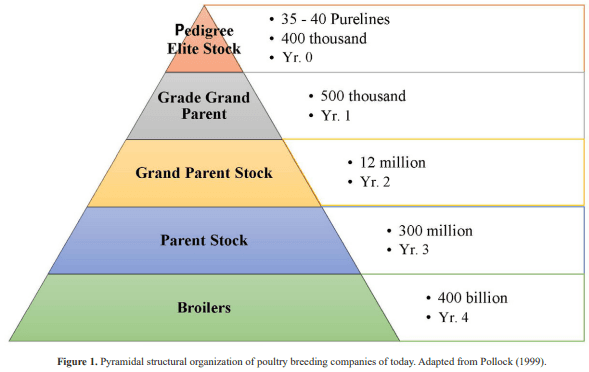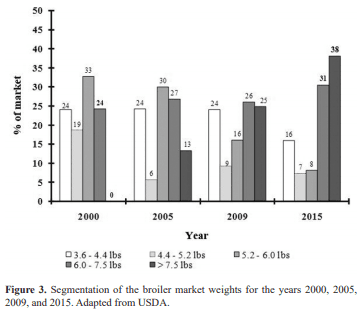Introduction
The poultry industry, more specifically, the broiler industry, plays a key role in the delivery of high quality protein and lipids to the world population. Per capita consumption of chicken meat of both developed and underdeveloped nations increased greatly from 1995 through 2005 (Scanes, 2007). This was, in part, because unlike red meats, there are no religious or cultural constraints associated with poultry meat consumption. Additionally, global prices of chicken meat and chicken meat products have remained relatively cheaper than beef and pork. In the US alone for the year 2012, according to estimations from the USDA Economic Research Service (2015), chicken meat was sold at a retail price ($1.335/ lb) that was 25 and 33% cheaper than beef ($5.25/lb.) and pork ($3.60/lb), respectively. The reason for these cheaper prices is due to the broiler industry being able to attain tremendous productivity and efficiency over the years (Scanes, 2007). For example, in 1957, a 42-d-old broiler weighed 586 g with a feed conversion ratio (FCR—g of feed/g of BW gain) of 2.8. While today, a broiler of the same age weighs 2,900 g with an FCR under 1.70 (Zuidhof et al., 2014). The cause behind these improvements is linked to enhance production technologies that boost performance such as improved genetics and breeding, better understanding of nutrition and feeding, and overall improved management techniques.
Improved genetics and breeding account for approximately 80 to 90% of the above mentioned production improvements observed today (Sherwood, 1977; Havenstein et al., 1994a,b; Havenstein et al., 2003a,b). However, it is important to understand that to maximize the genetic potential of a bird, proper nutrition and management of the environment must be provided; thus, all aspects need to work in conjunction with each other.
The objective of the following review was to understand the impact of genetics and breeding on broiler production performance. Relevant information pertinent to selection of performance traits of economic importance, as well as current and future trends driving genetic improvement in the broiler industry, will be discussed.
Genetics and Breeding as Performance-enhancing Technology
General overview
Breeding companies have used population genetics through quantitative selection practices since the 1940s to improve productivity and efficiency in the poultry industry today (Hunton, 2006). The organizational structure of today’s breeding companies is very similar around the world as its follows a pyramidal structure (Figure 1). The top of the pyramid is occupied by a relatively small population of pureline elite stock and a larger population of broilers at the base. Additionally, the genetic lag time from pureline to meat-type birds is 4 yr. Furthermore, a report by Pollock (1999) indicated that approximately 400,000 pedigree birds from 35 to 40 purelines, which represent the genetic stock of the industry, supplied billions of broilers to the market. These pedigree populations are first categorized into male and female lines and then undergo intensive genetic selection to obtain incremental improvements in the major economic traits. In the male lines, genetic selection is emphasized on traits such as growth rate, edible meat yield, and feed efficiency. While in the female lines, traits such as growth rate, edible meat yield, egg production, and feed efficiency (to a lesser extent) are emphasized.
Feed conversion ratio is an indirect indicator of performance efficiency. It indicates the amount of feed consumed to obtain one unit of weight gain on the live bird in a given period of time. It is expressed as the ratio of feed intake over live weight gain.
The broiler industry was characterized as an age-for-weight market industry with slaughter at a fixed target weight; therefore, emphasis was placed on rapid growth and early carcass development (Emmerson, 1997). The explanation was that processors demand chicken products, including bone-in and boneless pieces, within a narrow weight range. This forces producers to raise and market birds at a fixed target weight to satisfy market demands.

Over the last 20 yr, breeding companies have gone a step further by placing emphasis on breast meat yield, and as a result, eviscerated yield has also increased considerably. This is in response to changes in consumer preferences for further processed items and an increase in demands in the food service sector. As evidence, in 1962, 83% of broilers in the US were marketed as whole carcass, 15% as cut-up birds or pieces, and 2% as further processed value-added items. By 2009 only 12% of broilers were marketed as whole birds, 42% as cut-up birds or pieces, and 46% as further processed products (Figure 2; National Chicken Council, 2011).
The change in consumer preference for pieces, rather than whole birds, and further processed products has to do with changes in the American household. One characteristic of the American family over the last 30 yr is that both the wife and husband have jobs. Therefore, time availability to prepare a meal is scarce, and food items need to be ready in a few minutes. Additionally, the demand for pieces has not only to do with time availability but also with the skills required to cut up a whole bird into usable pieces. It is generally assumed most consumers are not capable of completing such tasks.
In more recent times, consumers have become more conscious of their eating habits. This creates a demand for the “white meat” portion (breast meat) of the bird because of a lower fat content compared with dark meat of the same broiler carcass. However, in other regions of the world, such as Asia and Latin America, demand for whole carcasses still exists and is projected to continue for years to come. Still, demand of breast meat has increased in these markets over the years. This is largely due to cultural customs and beliefs, as people in these regions generally prefer to buy broiler meat at markets. Typically, consumers in these markets buy live birds as a means of proof of “freshness” and “wholesomeness.”
Performance traits of economic importance
A study conducted in Brazil with approximately 29, 000 broilers reported heritability and correlation coefficients of some traits of economic importance for the broiler industry (Table 1; Gaya et al., 2006). Among these traits, body weight at 38 d of age and abdominal fat content had the greatest heritability with 0.40 and 0.53, respectively. Meanwhile, feed intake and feed conversion ratio had the lowest heritability with 0.20 and 0.16. Additionally, body weight at 42 d of age was highly correlated with feed intake, eviscerated body weight, and leg weight. In a similar manner, feed intake was also highly correlated with breast weight and abdominal fat content. Feed conversion ratio, an indirect indicator of feed efficiency, had a relatively intermediate correlation with body weight at 42 d of age, feed intake, and abdominal fat content. Similar correlations were also reported in other studies (Cahaner and Nitsan, 1985; Le Bihan-Duval et al., 1998; Konarzewski et al., 2000; Argentão et al., 2002; Rance et al., 2002). These results would explain that current broilers are not only being selected for heavier body weights, but also that intense selection for this particular trait is associated with increased feed intake and increased meat yield, which results in heavier breast meat but more abdominal fat. Additionally, there was a strong correlation between body weight at 38 d of age with heart and other viscera weight but not at 42 d of age. This would indicate that as the industry continues to grow heavier birds past 42 d of age, the heart might not grow at the same pace as the body does.
Growth rate, typically expressed as the amount of weight gain over a period of time (g/d), is a moderate to highly heritable trait and can also be easily improved via intense mass selection (Emmerson, 1997). However, there are unintended negative side effects of the intense selection for growth rate. Because so much selection pressure has been applied to growth rate, reproductive performance has decreased while abdominal fat, ascites, and skeletal abnormalities have all increased (Chambers, 1990; Julian and Mirsalimi, 1992; Riddell, 1992; Lilburn, 1994). It’s believed that metabolic imbalances associated with rapid growth are the cause of these unintended results, and thus growth alone should not be seen as the root problem (Julian, 1998).


Usually, breeding companies recommend coping with the effects of these unintended results with better nutrition and management practices. Breeding companies are beginning to select against some of these unintended issues. As an example, leg and heart weight each have intermediate heritability estimates and are therefore being used as selection tools to increase skeletal integrity (leg weight) and overall health (heart weight) (Konarzewski et al., 2000; Gaya et al., 2006).
Traditionally, breeding companies select for feed efficiency indirectly using traits such as body weight at 42 d because faster-growing birds reach a target market weight in a shorter amount of time than their slow-growing counterparts. This approach has resulted in undesirable traits already discussed above. However, the direct approach penalizes heavier birds for selection purposes as older birds have a greater maintenance requirement and thus are less feed efficient. Additionally, feed efficiency, for practical purposes, has also been defined as an input–output ratio in broilers (Skinner-Noble and Teeter, 2004; Lassiter et al., 2006) and broiler breeder hens (de Beer and Coon, 2007). A different approach is to select for efficiency based on residual feed intake (RFI). This measurement of feed efficiency is defined as the portion of the metabolizable energy intake not explained by metabolic body weight, average daily gain, and egg mass production (Romero et al., 2009). It is estimated by obtaining the differences between observed and expected metabolizable energy intake with the use of linear and nonlinear regression models (Flock, 1998; van Eerden et al., 2004; Zuidhof et al., 2014). This selection criterion takes into consideration variation in feed intake attributed to differences in body weight and other energy requirement outputs and has resulted in an intermediate heritable trait in laying hens (Wing and Nordskog, 1982). The issue with residual feed intake is that it is confounded with feed intake in broiler breeder hens and thus limits its value as selection criteria in meat type birds.
In contrast, a more novel approach to directly measure feed efficiency in meat-type birds is the residual maintenance requirement, which calculates the difference between observed and expected maintenance requirements. In a study conducted by Romero et al. (2009) in broiler breeder hens, residual maintenance requirements were highly correlated with egg production, chick production, and feed conversion per chick while having little association with feed intake. Therefore, the authors concluded this approach provides an unbiased estimate of energetic efficiency by adjusting the maintenance requirement for the effect of dietary thermogenesis. In another study, Zuidhof et al. (2014) reported that residual maintenance requirements of broilers from 1957 was numerically greater than those from 2005 although not statically significant. These results would suggest that broilers from 1957 are less biologically efficient than 2005 broilers.
Current trends
Production performance in the broiler industry is constantly evolving due to research conducted in genetics and breeding. A recent study by Zuidhof et al. (2014) compared genotypes representative of those in the broiler industry of the years 1957, 1978, and 2005. From 1957 to 2005, body weight was improved by 460% (0.90 vs. 4.20 kg) and feed conversion rate reduced by 50% (2.854 vs. 1.918; g of feed/g of BW gain) over a 56-d grow-out period, corresponding to a compound annual rate of increase in 42 d live body weight of 3.30%.
The practical implications of these improvements in performance are reflected in today’s market weight in the US broiler industry. Data from the years 2000 to 2015 indicate that the average market weight has increased from 2.3 (5.10) to 2.8 kg (6.2 lb). In the same period of time, the percent of the population marketed over 2.7 kg (6 lb) has changed from 24 to 69 (Figure 3; USDA Economic Research Service, 2006; Coon, 2015). The reason for the increase is processor demand for breast meat and deboned meat to satisfy consumers and the food service sector. The poultry processing industry has been very successful at creating value-added food items such as loaves, rolls, ham-type products, sausages, and other ready-to-eat products.

Consumers’ concern for the well-being of production animals is a challenge of today’s agriculture, and the poultry industry is no exception. The genetic markers for stress in meat-type birds have been identified, and breeding companies have the ability to incorporate these markers in their selection programs and thus help birds cope with stressors (Cheng, 2010).
Future considerations
Genetics will continue to be the main driver for production performance improvements in the broiler industry. It is hard to believe that genetic improvement has not reached a biological threshold. However, according to recent projections from Agri-Stats, Inc. presented by Donohue (2015), by the year 2034, the broiler body weight of a 2.34-kg (5-lb) bird will be reached by the end of a 28.8-d growing period. This will be the result of genetic improvement to reach this weight, and the growing period is projected to be reduced at a rate of 0.56 d/yr. The main benefit of selecting birds for faster growth rate is improved feed efficiency. This means that the faster broilers reach the desired market size, the greater the percentage of nutrients from the diet go to lean mass accumulation as opposed to body maintenance. As broilers get older, feed conversion rate decreases because more feed is consumed and a greater proportion of nutrients go to maintenance.
The seed stock of poultry genetics is more centralized than ever before because a few companies own the market. On the contrary, broiler production is a global phenomenon as South and Central American and Asian countries are among the main producers. The environmental and management conditions in these regions are vastly different than those where seed stock was raised. This creates the opportunity for genetics companies to work on genotypes that are more appropriate to the conditions of the above-mentioned countries.
Conclusions
Intense genetic selection for economically important traits including body weight, growth rate, feed efficiency, and ultimately traits associated with carcass-processing characteristics have contributed to the increases in productivity and efficiency obtained in the broiler industry. Although these improvements have come with some unintended results (reduced reproductive performance, skeletal abnormalities, ascites, and increased abdominal fat), they are typically ameliorated with management and nutrition, and genetic selection will continue to be the main driver for improvement.
This article was originally published in Animal Frontiers, Volume 6, Issue 4, October 2016, Pages 37–41, https://doi.org/10.2527/af.2016-0042. This is an Open Access article distributed under the terms of the Creative Commons Attribution Non-Commercial License (http://creativecommons.org/licenses/by-nc/4.0/). 













.jpg&w=3840&q=75)